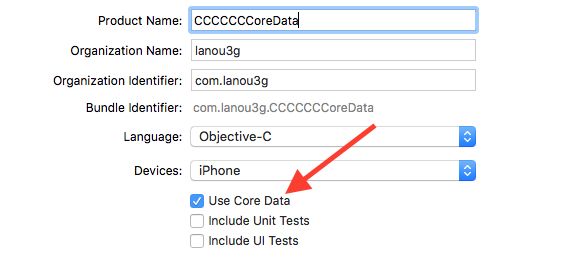一、CoreData介绍
CoreData是苹果公司封装的数据持久化框架。说白了就是对SQLite进行的封装 CoreData在iOS 3.0中开始开放, 它允许用户按照实体-属性-值模型组织数据,数据最终的存储形式可以是:二进制、XML、SQLite数据库、内存里、活自定义数据类型
如果要了解SQLite的的使用可以参阅博客 :http://www.jianshu.com/p/0b9b78e704a4
CoreData的优势:
1 它是苹果公司原生态的产品。
2 它可以节省代码量 大概是30%-70%。
3 它支持可视化建模。
4 CoreData支持数据库版本升级
CoreData的构成
(1)NSManagedObjectContext 被管理者对象上下文 相当于一个临时数据库 我们存储或者查询都是通过这个对象来的
(2)NSManagedObjectModel 被管理对象模型,可以简单的理解为可视化建模文件 我们在可视化建模中是Entity自动生成model 方便让文件存储助理来进行管理
(3)NSPersistentStoreCoordinator 文件存储助理,相当于数据库的链接器,它是CpreData的核心 他负责链接所有的模块 包括真实的存储文件
(4)NSManagedObject 被管理的数据记录, 相当于数据库中的表格记录
(5)NSFetchRequest 获取数据的请求,相当于SQL语句
(6)NSEntityDescription 实体结构,相当于表结构
(7)后缀为.xcdatamodeld的包 里面是.xcodemodel文件 用数据模型编辑器编译。编译后为.momd或.mom文件
二、使用简介
我们创建一个工程,在创建的时候选择使用 Core Data
在AppDelegate里面会相比不使用CoreData多出来几个属性和方法 在以下代码中都加了非常详细的代码
#import
#import
@interface AppDelegate : UIResponder
@property (strong, nonatomic) UIWindow *window;
//被管理对象上下文,相当于一个临时数据库 我们存储或者查询都是通过这个对象来的
@property (readonly, strong, nonatomic) NSManagedObjectContext *managedObjectContext;
//被管理对象模型,可以简单的理解为可视化建模文件 我们在可视化建模中是Entity自动生成model 方便让文件存储助理来进行管理
@property (readonly, strong, nonatomic) NSManagedObjectModel *managedObjectModel;
//文件存储助理,他是CpreData的核心 他负责链接所有的模块 包括真实的存储文件
@property (readonly, strong, nonatomic) NSPersistentStoreCoordinator *persistentStoreCoordinator;
//将我们在内存中的操作进行持久化
- (void)saveContext;
//获取真实文件的路径
- (NSURL *)applicationDocumentsDirectory;
@end
紧接着我们在点击后缀为.xcdatamodeld
接下来 并根据提示做如下操作
点击create
那么在我们的工程中就出现了类似下图的几个文件 我们在使用的时候直接引入头文件就可以Student.h或者Person.h就可以了
三、增、删、改、查的实现
接下来我们来实现什么功能呢?请看下图
我们创建一个类CoreDataTableViewController 继承自UITableViewController
.h
#import
#import "AppDelegate.h"
@interface CoreDataTableViewController : UITableViewController
//创建一个上下文对象 用于处理所有与存储相关的请求
@property(nonatomic,strong)NSManagedObjectContext *myContext;
//创建一个数组用于存储数组的数据源
@property(nonatomic,strong)NSMutableArray *allData;
@end
.m
- (void)viewDidLoad {
[super viewDidLoad];
//进行数据初始化
AppDelegate *delegate= [UIApplication sharedApplication].delegate;
self.myContext = delegate.managedObjectContext;
self.allData = [NSMutableArray array];
//通过coreData读取本地所有的数据
[self getAllDataFromCoreData];
}
1、增加
- (IBAction)addData:(id)sender {
//创建student对象
NSEntityDescription *description = [NSEntityDescription entityForName:@"Student" inManagedObjectContext:_myContext];
Student *student = [[Student alloc]initWithEntity:description insertIntoManagedObjectContext:_myContext];
//给属性赋值
student.name = @"张三";
student.age = arc4random()%73+1;
//修改数据源
[_allData addObject:student];
//修改界面
NSIndexPath *indexPath = [NSIndexPath indexPathForRow:self.allData.count -1 inSection:0];
[self.tableView insertRowsAtIndexPaths:@[indexPath] withRowAnimation:UITableViewRowAnimationLeft];
//将数据保存到文件中进行持久化
/*
// NSError *error = nil;
// [self.myContext save:&error];
//
// if (nil != error) {
// NSLog(@"数据持久化存在问题");
// }
*/
//等同于以上实例持久化方式
[(AppDelegate *)[UIApplication sharedApplication].delegate saveContext];
}
2、删除
-(void)tableView:(UITableView *)tableView commitEditingStyle:(UITableViewCellEditingStyle)editingStyle forRowAtIndexPath:(NSIndexPath *)indexPath{
if (editingStyle == UITableViewCellEditingStyleDelete) {
//获取当前cell代表的数据
Student *stu = _allData[indexPath.row];
//修改数据源
[self.allData removeObject:stu];
//更新UI
[self.tableView deleteRowsAtIndexPaths:@[indexPath] withRowAnimation:UITableViewRowAnimationLeft];
//将临时数据库里进行删除并进行本地持久化
[self.myContext deleteObject:stu];
[self.myContext save:nil];
}
}
3、修改
-(void)tableView:(UITableView *)tableView didSelectRowAtIndexPath:(NSIndexPath *)indexPath{
NSFetchRequest *fetchRequest = [[NSFetchRequest alloc] init];
NSEntityDescription *entity = [NSEntityDescription entityForName:@"Student" inManagedObjectContext:_myContext];
[fetchRequest setEntity:entity];
NSSortDescriptor *sortDescriptor = [[NSSortDescriptor alloc] initWithKey:@"age"
ascending:YES];
[fetchRequest setSortDescriptors:[NSArray arrayWithObjects:sortDescriptor, nil]];
NSError *error = nil;
NSArray *fetchedObjects = [_myContext executeFetchRequest:fetchRequest error:&error];
if (fetchedObjects != nil) {
//修改对应的数据
Student *stu = fetchedObjects[indexPath.row];
stu.name = @"尼古拉斯&赵四";
//更新数据源
[self.allData removeAllObjects];
[self.allData addObjectsFromArray:fetchedObjects];
//更新界面
[self.tableView reloadRowsAtIndexPaths:@[indexPath] withRowAnimation:UITableViewRowAnimationLeft];
//将修改本地持久化
[self.myContext save:nil];
}
}
4、查询
-(void)getAllDataFromCoreData{
NSFetchRequest *fetchRequest = [[NSFetchRequest alloc] init];
NSEntityDescription *entity = [NSEntityDescription entityForName:@"Student" inManagedObjectContext:_myContext];
[fetchRequest setEntity:entity];
// Specify criteria for filtering which objects to fetch
//排序条件
NSSortDescriptor *sortDescriptor = [[NSSortDescriptor alloc] initWithKey:@"age" ascending:YES];
[fetchRequest setSortDescriptors:[NSArray arrayWithObjects:sortDescriptor, nil]];
NSError *error = nil;
NSArray *fetchedObjects = [_myContext executeFetchRequest:fetchRequest error:&error];
if (fetchedObjects == nil) {
NSLog(@"两手空空,你让伦家盆满钵满");
}
//将查询到的数据添加到数据源
[self.allData addObjectsFromArray:fetchedObjects];
//重新加载tableView
[self.tableView reloadData];
}
四、关系建立
实际我们在项目中建立起来的模型对象并不是孤立存在的例如:Company(公司) 和 Employee(雇员)之间是存在归属关系的 我们就依此为例
首先我们创建两个模型对象 Company 和 Employee
那么我们如何建立起公司和职员之间的链接呢?往下看
代码实例如下:
#import "ViewController.h"
#import "Company.h"
#import "Employee.h"
#import "AppDelegate.h"
@interface ViewController ()
@property(nonatomic,strong)NSManagedObjectContext *myContext;
@end
@implementation ViewController
- (void)viewDidLoad {
[super viewDidLoad];
self.myContext = ((AppDelegate *)[UIApplication sharedApplication].delegate).managedObjectContext;
Company *company = [[Company alloc]initWithEntity:[NSEntityDescription entityForName:@"Company" inManagedObjectContext:self.myContext] insertIntoManagedObjectContext:self.myContext];
company.name = @"网易新闻";
company.address = @"中关村东路1号院清华科技园D座";
Employee *emp1 = [[Employee alloc]initWithEntity:[NSEntityDescription entityForName:@"Employee" inManagedObjectContext:self.myContext] insertIntoManagedObjectContext:self.myContext];
emp1.name = @"赵二";
emp1.age =21;
Employee *emp2 = [[Employee alloc]initWithEntity:[NSEntityDescription entityForName:@"Employee" inManagedObjectContext:self.myContext] insertIntoManagedObjectContext:self.myContext];
emp2.name = @"见哥";
emp2.age = 22;
[company addBelongObject:emp1];
[company addBelongObject:emp2];
[self.myContext save:nil];
#pragma mark ------模拟读取查询
NSFetchRequest *fetchRequest = [[NSFetchRequest alloc] init];
NSEntityDescription *entity = [NSEntityDescription entityForName:@"Company" inManagedObjectContext:self.myContext];
[fetchRequest setEntity:entity];
NSSortDescriptor *sortDescriptor = [[NSSortDescriptor alloc] initWithKey:@"name" ascending:YES];
[fetchRequest setSortDescriptors:[NSArray arrayWithObjects:sortDescriptor, nil]];
NSError *error = nil;
NSArray *fetchedObjects = [self.myContext executeFetchRequest:fetchRequest error:&error];
if (fetchedObjects == nil) {
NSLog(@"两手空空,大变活人");
}
Company *com =fetchedObjects[0];
//这里我们知道只是存了一个
NSLog(@"%@--%@",com.name,com.address);
for (Employee *em in com.belong) {
NSLog(@"name:%@,age = %d",em.name,em.age);
}
}
五、数据库版本升级
实际上开发过程中数据库的版本升级也是很常见的 怎么实现呢?在这里直接上图 简单明了
这时候我们多了新的.xcdatamodeld文件 绿色对勾表示当前选择数据库NSManagedObjectModel
以上就是关于CoreData的基本用法。










